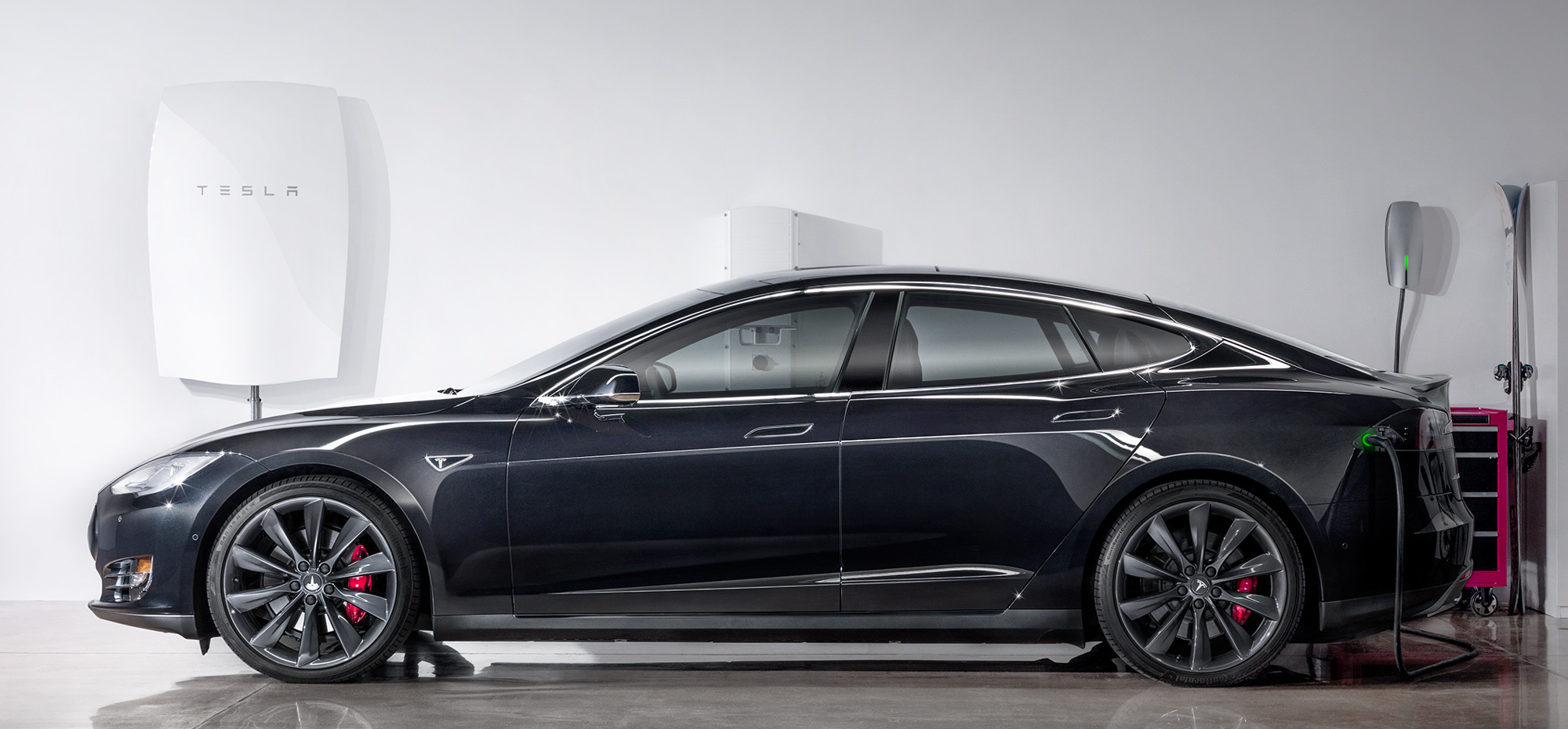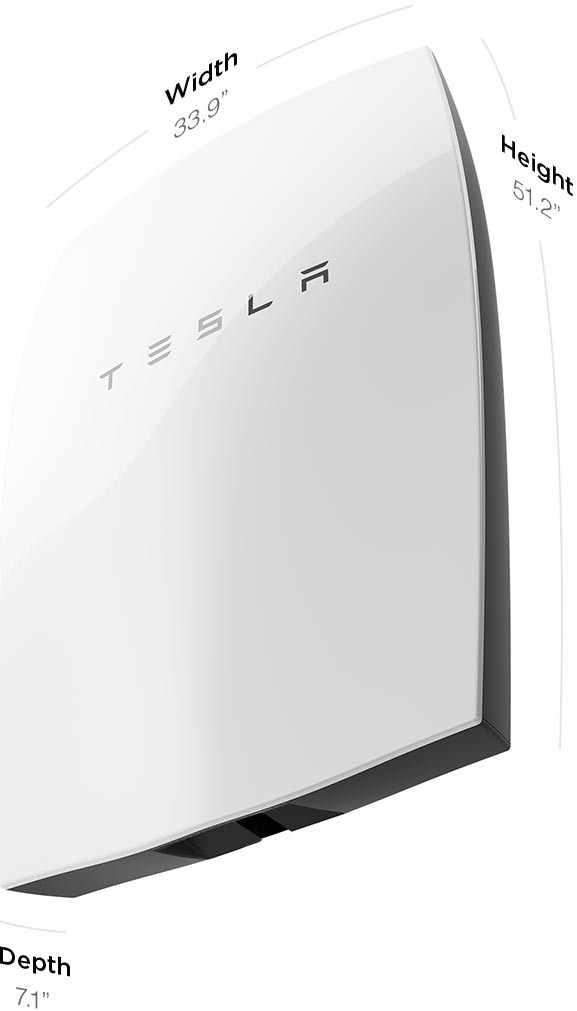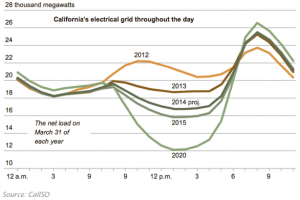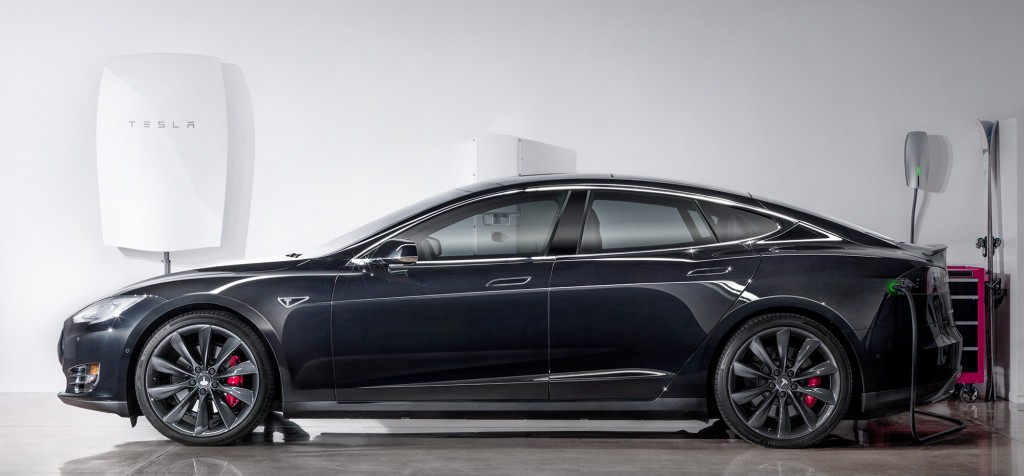Energy
Tesla PowerWall Debuts: $3,000 Home Battery
Tesla Energy has announced its new PowerWall residential storage battery. Price for a 7 kWh system is just $3,000. Several batteries can be interconnected.

The world got its first look at the Tesla PowerWall yesterday during a splashy debut presentation – an event powered solely by energy collected from solar panels earlier in the day and stored in an array of PowerWall batteries. In essence, the PowerWall is a large uninterruptible power supply for homes. Elon Musk was in particularly high spirits as he modestly proclaimed this new technology could eliminate the world’s need for fossil fueled electricity forever.

As technology journalist and Tesla owner Daniel Sparks correctly predicted on Tuesday, Tesla’s battery storage business will be conducted under the name Tesla Energy — a name the company reserved more than a decade ago. Tesla Energy will provide battery storage systems for three potential markets; residential, commercial and utilities.
Tesla PowerWall Residential System
The biggest news about the Tesla PowerWall battery storage system for residential customers is the price. A 7 kWh PowerWall is just $3,000. That’s far less than most observers expected. A 10 kWh system lists for $3,500. Do you need more than 10 kWh of storage? No problem. The units are designed so that as many as 9 of them can be plugged together for a total of 90 kWh of storage.
Here are the specs as provided by the Tesla Energy website:
- Technology Wall mounted, rechargeable lithium ion battery with liquid thermal control.
- Models 10 kWh $3,500 — for backup applications. 7 kWh $3,000 — for daily cycle applications
- Warranty Ten year warranty with an optional ten year extension.
- Efficiency 92% round-trip DC efficiency
- Power 2.0 kW continuous, 3.3 kW peak
- Voltage 350 – 450 volts
- Current 5 amp nominal, 8.5 amp peak output
- Compatibility Single phase and three phase utility grid compatible.
- Operating Temperature -4°F to 110°F / -20°C to 43°C
- Enclosure Rated for indoor and outdoor installation.
- Installation Requires installation by a trained electrician. AC-DC inverter not included.
- Weight 220 lbs / 100 kg
- Dimensions 52.1″ x 33.9″ x 7.1″ (130 cm x 86 cm x 18 cm)
- Certifications UL listed
Customers can sign up on the company website now to reserve a battery. Deliveries are expected to begin in late summer, with more capacity coming online as production at the Tesla GigaFactory begins in late 2016.
 The PowerWall will be marketed to all homeowners, not just those with solar panels or other renewable energy systems. The concept is simple. The battery gets charged overnight when electricity rates are lowest. Then it is used to power the home during the morning and evening peak usage times, saving the customer enough money to more than pay for the system and installation.
The PowerWall will be marketed to all homeowners, not just those with solar panels or other renewable energy systems. The concept is simple. The battery gets charged overnight when electricity rates are lowest. Then it is used to power the home during the morning and evening peak usage times, saving the customer enough money to more than pay for the system and installation.
If the customer has a home solar system, it will charge the PowerWall during the day, reducing the need to buy any electricity from the grid even further. Depending on local conditions, customers can even sell any excess power back to the local utility company, reducing their electric bills that much more.
Tesla PowerPack For Commercial Customers
 Tesla Energy has its sights on more than just residential customers. We know larger battery storage systems have been installed in 11 Walmart stores already. Now Amazon has committed to an enormous 4.8 mWh system for its western US data center, according to Gizmodo. Selected Target stores will also get Tesla Energy PowerPack systems.
Tesla Energy has its sights on more than just residential customers. We know larger battery storage systems have been installed in 11 Walmart stores already. Now Amazon has committed to an enormous 4.8 mWh system for its western US data center, according to Gizmodo. Selected Target stores will also get Tesla Energy PowerPack systems.
The benefits of on-site battery storage are magnified for large scale commercial operations. In the traditional business model used by utility companies. they have no choice but to buy power from the grid during peak demand times. Having on-site energy storage capability will allow then to charge their batteries when electricity costs the least and use that stored energy when it benefits them the most. Here’s more from the Tesla Energy website:
Based on the powertrain architecture and components of Tesla electric vehicles, Tesla energy storage systems deliver broad application compatibility and streamlined installation by integrating batteries, power electronics, thermal management and controls into a turn key system.
Tesla’s energy storage allows businesses to capture the full potential of their facility’s solar arrays by storing excess generation for later use and delivering solar power at all times. Business Storage anticipates and discharges stored power during a facility’s times of highest usage, reducing the demand charge component of the energy energy bills. Energy storage for business is designed to:
- Maximize consumption of on-site clean power
- Avoid peak demand charges
- Buy electricity when it’s cheapest
- Get paid by utility or intermediate service providers for participating in grid services
- Back up critical business operations in the event of a power outage
It’s a simple business case to make — our energy storage system will save your business tons of money. What business owner wouldn’t be happy with that?
Tesla Energy Grid Scale Storage
The most important part of Thursday’s announcement may turn out to be Tesla Energy’s entry into the grid scale energy storage market. Southern California Edison and OnCor have indicated interest in partnering with Tesla Energy on large scale energy storage installations. Elon Musk said Thursday night that phase of the business will be based on multiples of 100 kWh basic units that can interconnect to provide up to 10 megawatt-hours of electrical storage. Why is that important?
Since utility grids were first invented, the model has been for large generating plants located in or near major cities supplying electricity to the surrounding area. Eventually, long distance power transmission lines were constructed to connect those city scale power systems into regional power grids supplying millions of customers.
But renewable energy sources like wind or solar farms tend to focus on relatively small installations located far from urban centers. They feed their power into the grid from the edges, not from the middle. Roof top solar sytems for individual homes and small businesses feed small amounts of power into the grid from hundreds or even thousands of locations in the middle of the grid.
Utility grids are simply not constructed to behave efficiently with all that electricity being supplied from multiple sources. Home solar in particular has led to a dramatic increase in voltage fluctuations across entire grids. If those fluctuations are large enough, they can damage computers and other digital devices. Grid scale storage batteries can absorb all those spikes and fluctuations coming in and feed clean, well regulated electricity back out.
Generating plants and utility grids are expensive to build and maintain. Industry observers estimate utility companies in North America will need to spend as much as $ 1.5 trillion dollars by 2030 to build new electric generating facilities and maintain the utility grid. Some industry executives suggest that the best way to move forward is to dismantle the grid and transition to a microgrid model.
According to Green Tech Media, David Crane, CEO of NRG Energy, told an industry conference in February, 2014, “There will come a day, in a generation or so, when the grid is at best an antiquated system to a completely different way of buying electricity. Everyone just stop a moment and think how shockingly stupid it is to build a 21st-century electric system based on a system of 130 million wooden poles. Stop trying to rearrange the deck chairs on the Titanic, and start talking about, ‘How do we get rid of the grid?’”
Elon Musk will be more than happy to help Crane and his peers get rid of their grid. In his remarks, he told the audience that with 2 billion batteries and a lot of solar panels, the world could finally stop using fossil fuels to generate electricity altogether. He added that microgrids and renewable energy could empower large segments of the world’s population who presently have no access to electric power. Musk has always been a champion of ” disruptive technology.” It doesn’t get much more disruptive than dismantling the electrical grid and making electric utilities obsolete.
Demand curve chart via CaliSO

Cybertruck
Tesla updates Cybertruck owners about key Powershare feature

Tesla is updating Cybertruck owners on its timeline of a massive feature that has yet to ship: Powershare with Powerwall.
Powershare is a bidirectional charging feature exclusive to Cybertruck, which allows the vehicle’s battery to act as a portable power source for homes, appliances, tools, other EVs, and more. It was announced in late 2023 as part of Tesla’s push into vehicle-to-everything energy sharing, and acting as a giant portable charger is the main advantage, as it can provide backup power during outages.
Cybertruck’s Powershare system supports both vehicle-to-load (V2L) and vehicle-to-home (V2H), making it flexible and well-rounded for a variety of applications.
However, even though the feature was promised with Cybertruck, it has yet to be shipped to vehicles. Tesla communicated with owners through email recently regarding Powershare with Powerwall, which essentially has the pickup act as an extended battery.
Powerwall discharge would be prioritized before tapping into the truck’s larger pack.
However, Tesla is still working on getting the feature out to owners, an email said:
“We’re writing to let you know that the Powershare with Powerwall feature is still in development and is now scheduled for release in mid-2026.
This new release date gives us additional time to design and test this feature, ensuring its ability to communicate and optimize energy sharing between your vehicle and many configurations and generations of Powerwall. We are also using this time to develop additional Powershare features that will help us continue to accelerate the world’s transition to sustainable energy.”
Owners have expressed some real disappointment in Tesla’s continuous delays in releasing the feature, as it was expected to be released by late 2024, but now has been pushed back several times to mid-2026, according to the email.
Foundation Series Cybertruck buyers paid extra, expecting the feature to be rolled out with their vehicle upon pickup.
Cybertruck’s Lead Engineer, Wes Morrill, even commented on the holdup:
As a Cybertruck owner who also has Powerwall, I empathize with the disappointed comments.
To their credit, the team has delivered powershare functionality to Cybertruck customers who otherwise have no backup with development of the powershare gateway. As well as those with solar…
— Wes (@wmorrill3) December 12, 2025
He said that “it turned out to be much harder than anticipated to make powershare work seamlessly with existing Powerwalls through existing wall connectors. Two grid-forming devices need to negotiate who will form and who will follow, depending on the state of charge of each, and they need to do this without a network and through multiple generations of hardware, and test and validate this process through rigorous certifications to ensure grid safety.”
It’s nice to see the transparency, but it is justified for some Cybertruck owners to feel like they’ve been bait-and-switched.
Energy
Tesla starts hiring efforts for Texas Megafactory
Tesla’s Brookshire site is expected to produce 10,000 Megapacks annually, equal to 40 gigawatt hours of energy storage.

Tesla has officially begun hiring for its new $200 million Megafactory in Brookshire, Texas, a manufacturing hub expected to employ 1,500 people by 2028. The facility, which will build Tesla’s grid-scale Megapack batteries, is part of the company’s growing energy storage footprint.
Tesla’s hiring efforts for the Texas Megafactory are hinted at by the job openings currently active on the company’s Careers website.
Tesla’s Texas Megafactory
Tesla’s Brookshire site is expected to produce 10,000 Megapacks annually, equal to 40 gigawatt hours of energy storage, similar to the Lathrop Megafactory in California. Tesla’s Careers website currently lists over 30 job openings for the site, from engineers, welders, and project managers. Each of the openings is listed for Brookshire, Texas.
The company has leased two buildings in Empire West Business Park, with over $194 million in combined property and equipment investment. Tesla’s agreement with Waller County includes a 60% property tax abatement, contingent on meeting employment benchmarks: 375 jobs by 2026, 750 by 2027, and 1,500 by 2028, as noted in a report from the Houston Business Journal. Tesla is required to employ at least 1,500 workers in the facility through the rest of the 10-year abatement period.
Tesla’s clean energy boom
City officials have stated that Tesla’s arrival marks a turning point for the Texas city, as it highlights a shift from logistics to advanced clean energy manufacturing. Ramiro Bautista from Brookshire’s economic development office, highlighted this in a comment to the Journal.
“(Tesla) has great-paying jobs. Not just that, but the advanced manufacturing (and) clean energy is coming to the area,” he said. “So it’s not just your normal logistics manufacturing. This is advanced manufacturing coming to this area, and this brings a different type of job and investment into the local economy.”
Energy
Tesla and Samsung SDI in talks over new US battery storage deal: report
The update was related by industry sources and initially reported by South Korean news outlets.

Recent reports have suggested that Tesla and Samsung SDI are in talks over a potential partnership to supply batteries for large-scale energy storage systems (ESS).
The update was related by industry sources and initially reported by South Korean news outlets.
ESS batteries to be built at Samsung’s Indiana plant
As noted in a report from Korea JoongAng Daily, the demand for energy storage systems has been growing rapidly in North America, thanks in no small part to the surge in AI investments across numerous companies. With this in mind, Tesla has reportedly approached Samsung SDI about a potential battery supply deal.
The deal is reportedly worth over 3 trillion Korean won (approximately $2.11 billion) and will span three years, according to The Korea Global Economic Daily. A battery supply deal with Samsung SDI could make sense for Tesla as the company already has a grid-scale battery, the Megapack, which is perfect for industrial use. Samsung SDI could simply supply cells for the EV maker.
Production of the batteries would reportedly take place at Samsung SDI’s joint venture factory with Stellantis in Indiana, which is currently under construction. Samsung SDI recently announced plans to use part of that plant’s EV lines to produce cells for ESS, with a targeted capacity of 30 GWh by the end of next year.
Tesla and Samsung’s partnership
At present, only a handful of manufacturers, including Korea’s LG Energy Solution, Samsung SDI, SK On, and Japan’s Panasonic, are capable of producing energy storage-scale batteries domestically in the United States. A Samsung SDI official issued a comment about the matter, stating, “Nothing has been finalized regarding cooperation with Tesla.”
The possible energy storage system deal adds another layer to Tesla’s growing collaboration with Samsung, which is already in line as a partner in the upcoming production of Tesla’s AI5 and AI6 chips. Early sample manufacturing of the AI6 is expected to begin in South Korea, with mass production slated for Samsung’s Texas-based Taylor foundry when it starts operations.
The AI6 chip will power Tesla’s next wave of high-volume projects, including the Optimus humanoid robot and the autonomous Cybercab service. Musk has called the partnership with Samsung a “real collaboration,” adding that he personally plans to “walk the line” at the Taylor facility to speed up progress.









